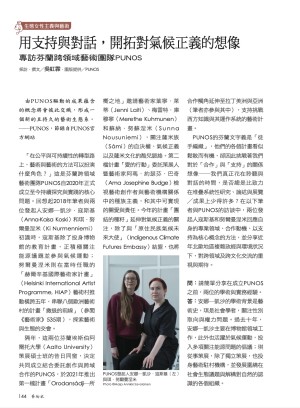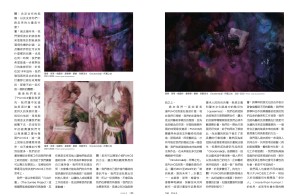Support and Dialogue as Ways to Expand the Imagination of Climate Justice

Summary:
Curator Hung-Fei Wu interviewed Punos for the ecofeminism column of Artist Magazine (Taiwan) in the summer of 2023. This is an English translation of the original text that was published in Chinese.

“The underlying idea is that the works facilitated by Punos will become intertwined, forming a new type of arts ecosystem in the long term. “
—Punos

"What role can art and artistic methods play in the transformation towards fairness and sustainability?" This has been the core question that Punos has been continuously exploring and practicing since its establishment in 2020. When I first met the two founders, Anna-Kaisa Koski and Ki Nurmenniemi, in 2018, Anna-Kaisa was actively engaged in museum education projects and was closely following energy issues and participating in climate movements. Ki, on the other hand, was working as a curator at the HIAP Artists-in-Residence program that initiated the project "Frontiers in Retreat," a five-year, eight-European-artist-residency initiative exploring the intersection of art and ecology.
The following year, these two former classmates from the Aalto University Curating Master's program decided to establish Punos, which combines commissioned art projects and collaboratives practices. Their first project, "Orodansádji – A Place to Be" (2021-2022), invited artists Jenni Laiti, Merethe Kuhmunen, and Sunna Nousuniemi to explore the themes of self-determination of the Sámi people, climate justice, and queerness within the context of Sámi culture. Their second project, "Acts of Love," commissioned curator and artist Ama Josephine Budge to examine issues of racism in the relationships between artists and art institutions, and explore possibilities of care and responsibility within those relationships. This year's project, "Seeds for Solidarity," extends their focus on climate justice not only by collaborating with the Indigenous Climate Futures Embassy but also expanding geographically to Latin America and Asia(I also participated in this project), challenging Western knowledge and operational systems through artistic projects .
While Punos' projects may appear loose, fluid and organic, they challenge our imagination of the essence of the idea of "collaboration" and "support." Does the time we truly dedicate to listening and dialogue always pale in comparison to our commitment to systematic research, discourse, and exhibitions/results?
In the following interview, the two founders respond to questions about their professional backgrounds, motivations for collaboration, the methodology centered around support, and share their perspectives on the significance and expectations of interdisciplinary and cross-cultural exchanges in the complex socio-political and environmental context of the Nordic region in recent years. It is hoped that this interview serves as a reference for cultural exchange and interdisciplinary ecological practices.
Fei: Before working together as Punos, please introduce your previous training and practices as individuals.
Punos: Anna-Kaisa’s background is in art theory, and Ki’s a sociologist with a focus on gender perspectives and questions of power. During the past decade, Anna-Kaisa has been working in the museum field with a focus on participation. She’s also been active in the climate movement, and done a lot of campaigning work focusing on energy questions. Ki has worked as a curator, both independently and within the field of artist residencies, developing initiatives around socio-ecological issues and deconstructing understandings of nature.
Fei: What made you decide to work together, and what’s the supporting force to sustain you and keep you committed and motivated?
Punos: Over the years, our conversations over coffee started to revolve increasingly around the climate and the environmental crisis, and the role we saw the art field could have in responding to them. We also both had a growing interest towards conducting our own research, and in 2019, at a time when we were both happening to be wrapping up other projects, we noticed that we could have something brewing to build a new initiative for.
This evolved into Punos Arts and Research, of which we don’t yet know if it’s a project or something more long-lasting. To be brutally honest about what is sustaining us, it is long-term funding. Without having four years of funding to focus on Punos we couldn’t have been as consistent as we have been, and we couldn’t have learned as much as we have. Our project structure that combines curatorial work and our doctoral research processes, also gives us an opportunity to focus on learning, and incorporating those learnings to the thinking informing other Punos work.
Since the beginning, we’ve been inspired by the climate organization Sunrise Project’s mission of enabling others to do their best work rather than trying to do it ourselves. We keep coming back to the question of how we can best provide support and resources for our collaborators. This mission of catering to others’ needs in order for them to be able to do their important work, keeps us motivated.
Fei: I don’t think in Taiwan we have an identical project like you, can you briefly introduce your methodology to familiarize the audience here?
Punos: We consider ourselves as a commissioning platform for contemporary art. We don’t have an exhibition space, so things are very open in terms of where we are. Our methodology in all its simplicity is based on conversation and dialogue.
We’ve been circling around in trying to articulate what we actually do, and now understand our primary role in supporting development of artist’s ideas, and resourcing the time it takes for ideas to emerge, to take shape, to develop. We understand the key role of Punos to be supporting artistic work. The outcomes of that work, the artworks, then might follow from the processes we initiate, and our hope is to be able to support the future circulation of these ideas and works in various institutional contexts.
Punos’ first art commission ‘Orodansádji – A Place to Be’– that has been a part of our ‘Whose Climate, Whose Futures?’ (2021–2024) project was created by Jenni Laiti, Merethe Kuhmunen and Sunna Nousuniemi. Orodansádji focuses on the Sámi people’s right to self-determination, climate justice, and queerness in the context of Sámi culture. We started our collaboration during the Covid-19 pandemic and the repeated lockdowns and other restrictions forced us to adjust our plans constantly. We wanted to start out with an intention to just talk, and give ourselves time to get to know each other, but repeatedly the conversations led to planning for something more concrete to happen. The situation with Covid eventually stopped those plans from happening, but what eventually became the commission is the idea of orodansádji, which in Northern Sámi language means a place where you can just be. It is a place “where we dream our dreams and they come to life”, as the artists describe it.
Fei: Punos has a particular focus on cross-disciplinary collaboration, why is this approach so important? What kind of discourses, knowledges or practices would particularly attract you?
Punos: Working across disciplines and cultures means that points-of-views will differ. Initially our interest in cross-disciplinary collaboration stems from our own educational and work backgrounds as well as from the understanding that art and its practices are crucially needed in building more sustainable futures. The narratives for just climate futures call for imagination and creative approaches.
Both of us have some background in doing things together, and thinking together (i.e. climate movement, artist residency communities, cooperatives for cultural workers). We see that communities, be they temporary or more permanent, are needed for building towards a more ecologically and socially sustainable society.
The two of us bring different discourses to Punos’ work. Ki is working with entangled and queer ecologies, the more-than-human world, and thinking about socio-ecological transformations. Anna-Kaisa is into people-focused approaches of energy humanities. We bring different starting points and terminologies into conversations with the issues we are dealing with. Supporting artist collaborations, we also aim to enable similar dialogues and diversification of ideas.
Fei: How do the Nordic geo-politics and geo-climates shape the local art policy, relationship with industries, and art practices? What’s your vision and expectations on cross-cultural exchange?
Punos: That’s a big question. The past decade has been so dense with various changes and political conflicts that it feels quite difficult to state anything all-encompassing about the Nordic geo-politics. Considering cross-cultural exchange, the rise of right-wing populist parties during 2000’s has brought about both narratives and policies of withdrawing from international arenas and turning inwards. Thinking of the climate aspect, the Nordic countries are one of the biggest per capita climate polluters, but the cold climate means that the devastating effects of climate change will hit other regions harder. And of course, the challenges faced in the most affected areas are not only limited to natural disasters brought about by the climate crisis, but are often rooted in the unjust (geo)political and/or cultural circumstances of local or global uneven distribution of resources. The Nordic countries have been deeply entangled in creating and up-keeping this unjust system.
How does this shape art policies and art practices then? The Nordic welfare state model has had a strong emphasis on the public funding for arts and an active art world has been considered an important element of people being able to live a good life. So the basic structure and ongoing support for arts exists. With Punos we approach the system conversely by thinking that what happens in the art world first, hints and signals on what will follow in societies and in the world at large. So if we can support more cross-cultural exchange in the arts, it will have an effect on the future. What it could be, we can’t tell, but it comes back to meaning-making, imagining differently, and creating ideas.
